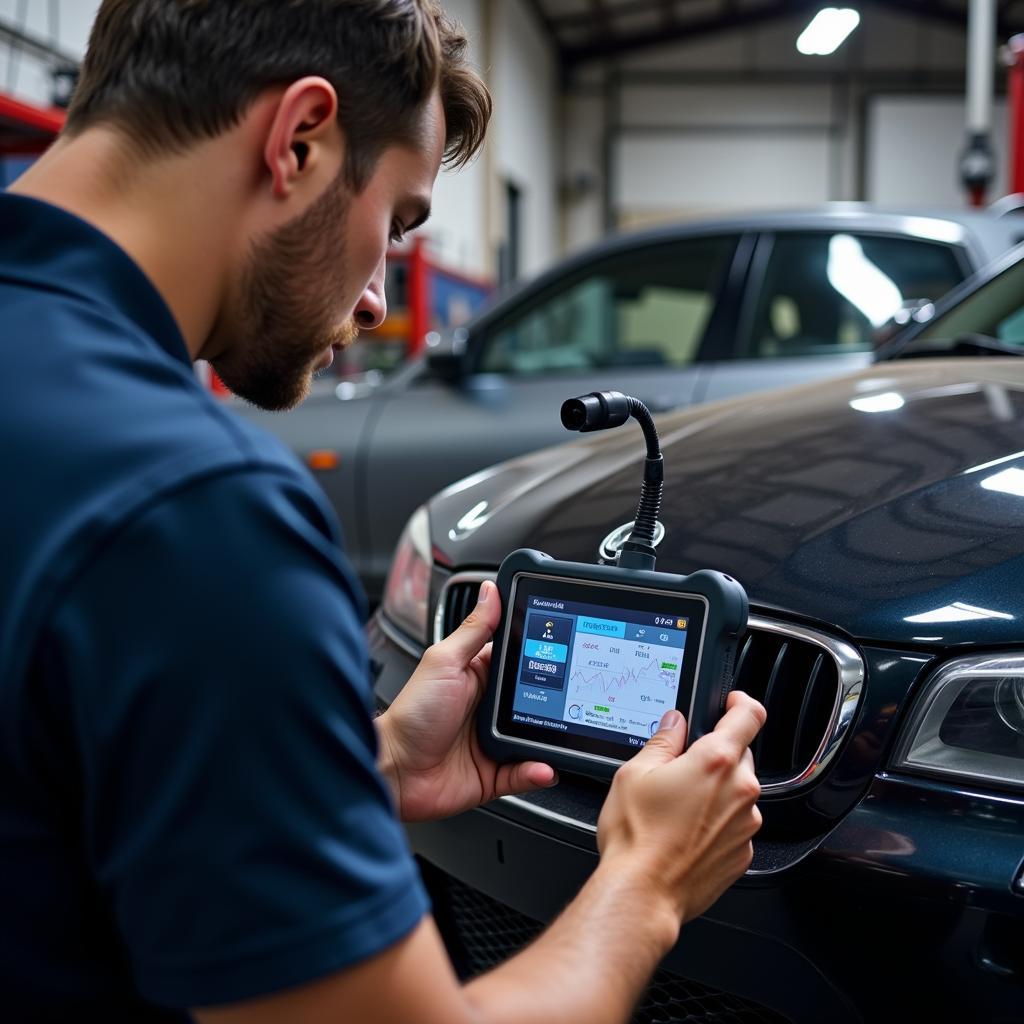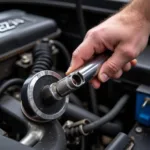A “tool light in car,” often represented by a wrench or spanner icon, is a crucial indicator of your vehicle’s health. It signals that your car’s onboard diagnostic system (OBD-II) has detected a potential issue. Understanding what triggers this light and how to address it can save you time, money, and potential headaches down the road. This article delves into the intricacies of the tool light, empowering you to take control of your car’s maintenance. See how you can easily understand and address this important car warning.
Modern vehicles are equipped with sophisticated computer systems that constantly monitor various aspects of engine performance, emissions, and other crucial systems. When the system detects a problem, it illuminates the tool light to alert the driver. While this light can be concerning, it doesn’t always signify a catastrophic failure. It can range from minor issues like a loose gas cap to more serious problems requiring professional attention. Identifying the root cause is key to addressing the issue effectively. For a more streamlined process in identifying potential car light bulb issues, you can refer to is there a tool to take out car light bulbs.
What Triggers the Tool Light?
The tool light can be triggered by a wide range of issues, from simple maintenance reminders to complex mechanical or electrical faults. Some of the most common causes include:
- Emissions Problems: A malfunctioning oxygen sensor, catalytic converter, or evaporative emissions system can trigger the tool light. These issues can affect fuel efficiency and contribute to increased emissions.
- Sensor Malfunctions: Modern cars rely on numerous sensors to monitor various systems. A faulty sensor can send inaccurate readings to the OBD-II system, triggering the tool light.
- Transmission Issues: Problems with the transmission, such as slipping gears or low fluid levels, can activate the light.
- Spark Plugs and Ignition System: Worn-out spark plugs or issues with the ignition coils can lead to misfires and trigger the tool light.
- Loose Gas Cap: Surprisingly, a loose or damaged gas cap can trigger the tool light as it can affect the evaporative emissions system.
Diagnosing the Tool Light
While the tool light itself doesn’t pinpoint the exact problem, it serves as a valuable starting point. The most effective way to diagnose the issue is to use an OBD-II scanner. This device plugs into your car’s diagnostic port and retrieves the specific trouble codes stored in the OBD-II system. These codes provide valuable clues about the nature of the problem.
Understanding these codes requires a reliable resource. Check out resources like the charger battery car mac tools bch 7120 flashing light page for more specific troubleshooting information. Once you have the codes, you can research their meaning and determine the appropriate course of action.
What to Do When the Tool Light Comes On
When the tool light illuminates, don’t panic. Here’s a step-by-step guide to help you navigate the situation:
- Check the Gas Cap: Ensure the gas cap is securely tightened. Sometimes, this simple fix can resolve the issue.
- Note Any Other Symptoms: Pay attention to any unusual noises, performance issues, or changes in fuel efficiency. These observations can provide valuable clues for diagnosis.
- Use an OBD-II Scanner: Retrieve the trouble codes from the OBD-II system. This is the most effective way to identify the underlying problem.
- Research the Codes: Use online resources or repair manuals to understand the meaning of the retrieved codes.
- Determine the Next Steps: Based on the code and your research, decide whether you can address the issue yourself or if professional assistance is required. For assistance in choosing the right car lights, consider the https://www.philips.co.uk/c-m-li/car-lights/car-selector-tool.html tool.
- Address the Issue: If it’s a simple fix like a loose gas cap, address it immediately. For more complex issues, consult a qualified mechanic.
 Mechanic Diagnosing a Car with a Diagnostic Tool
Mechanic Diagnosing a Car with a Diagnostic Tool
“Regular maintenance and timely attention to the tool light are essential for ensuring the longevity and reliability of your vehicle,” says John Smith, ASE Certified Master Technician. He adds, “Ignoring the tool light can lead to more serious and costly repairs down the line.”
Tool Light vs. Check Engine Light: What’s the Difference?
While both lights indicate a potential problem, they serve different purposes. The tool light often relates to maintenance reminders or issues that don’t directly impact emissions. The check engine light, on the other hand, specifically signals emissions-related problems. In some cases, both lights may illuminate simultaneously, indicating a more complex issue.
Ignoring the Tool Light: Potential Consequences
Ignoring the tool light can have serious consequences, leading to more extensive damage and costly repairs. Addressing the issue promptly can prevent further complications and ensure the longevity of your vehicle.
“Addressing the tool light promptly can save you money in the long run,” advises Jane Doe, Automotive Engineer. “Early detection and repair can prevent minor issues from escalating into major problems.”
Conclusion
The tool light in your car is a valuable tool that provides insights into your vehicle’s health. Understanding what triggers this light and how to address it can empower you to take control of your car’s maintenance and prevent costly repairs. By following the steps outlined in this article and utilizing resources like the disney cars 3 lightning mcqueen tool kit for basic maintenance, you can keep your car running smoothly and avoid potential headaches down the road. Remember, addressing the tool light promptly is crucial for maintaining the longevity and reliability of your vehicle.
FAQ
- What does the tool light mean? The tool light indicates a potential issue detected by your car’s onboard diagnostic system.
- Is it safe to drive with the tool light on? While you can sometimes drive short distances, it’s important to diagnose and address the issue promptly.
- How do I reset the tool light? After addressing the underlying problem, the tool light may reset automatically or require manual reset using an OBD-II scanner.
- Can a loose gas cap trigger the tool light? Yes, a loose or damaged gas cap can affect the evaporative emissions system and trigger the light.
- What is the difference between the tool light and the check engine light? The tool light relates to general maintenance or non-emissions related issues, while the check engine light specifically signals emissions problems.
- How much does it cost to diagnose the tool light? Diagnostic costs vary, but using an OBD-II scanner can save you money on initial diagnosis.
- Where can I find more information about specific trouble codes? Online resources, repair manuals, and automotive forums can provide detailed information about specific trouble codes.
Need more help? Contact us via WhatsApp: +1(641)206-8880, Email: [email protected] or visit us at 910 Cedar Lane, Chicago, IL 60605, USA. We have a 24/7 customer support team ready to assist you. You can also explore additional resources and articles on our website, such as cars fast as lightning hack tool for more specialized information.
